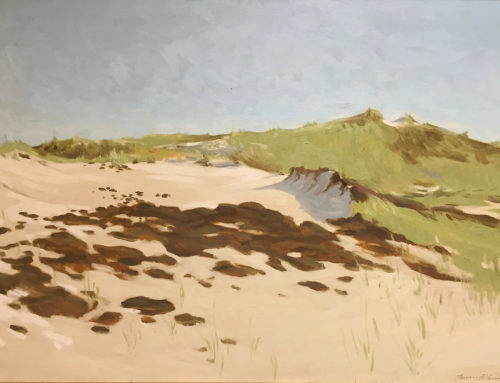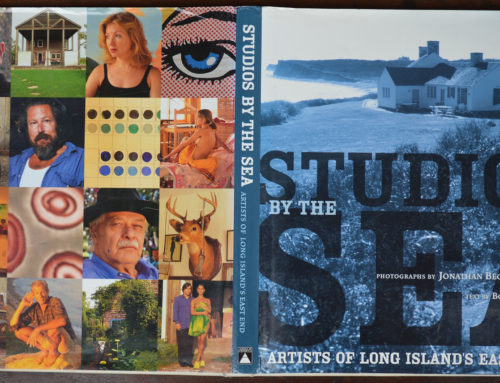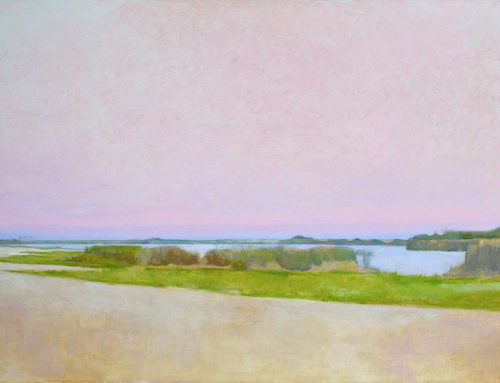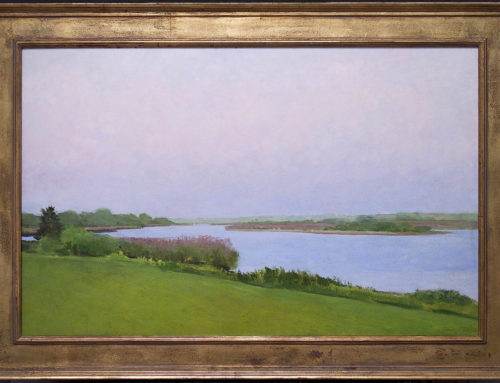As soon as you cross the railroad tracks going north on Lumber Lane it’s hard not to notice a beautiful old farmhouse on your left with it’s half round gable window and Italianate style porch. The barns around it and old chicken coop out buildings seem out of time and place compared to the second home building boom going on around the East End. I’d driven by here many times before I took an interest for the place and probably many more times before I actually committed to the idea of painting there. One afternoon in 2003-4 I set up across the road and started the first Hendrickson Farmhouse painting, then finished it in the studio. It turned into a night scene by accident. I think I wanted it to but was too afraid to try that color palette. I like the background more than the house, kind of moody or mysterious, suggestive and a lot of brush stroke in the foreground, underpainting and canvas showing through but the house has a glow like it’s being illuminated by bright full moon light.

Hendrickson’s Farmhouse, oil on canvas 30″x47″, private collection.
The house was built in 1866 and is still surrounded by the other original buildings on the property. I wanted to paint here, on the property but first I needed permission. So I mentioned this one day to a long time friend and art dealer, Gary Kephart who happened to know the owner, Dr. John Anton. He accepted my request to work there without actually trespassing. It’s definitely not a good idea to go on this property unless Anton knows you. This basically meant I could set up anywhere I wanted and Dr. Anton wasn’t living there at the time. The house, buildings and farm sits on 67 acres and still exists today much like it looked 100 years ago. After I met Dr. Anton and started working there he mentioned something about his farm in Vermont and said he intended to keep this farm in Bridgehampton just as it was, undeveloped. Before Dr Anton arrived, Richard Hendrickson lived in the house most of his life. He was born in Bridgehampton in 1913 and grew up here on his family farm. Beside his duties as a farmer collecting eggs, milking cows and cutting hay he is the record holding 80-year member of the Weather Service’s Corps of Cooperative Observers. This network was established in 1890 to help track meteorological data, usually consisting of daily maximum and minimum temperatures, snowfall, and 24-hour precipitation totals, required to define the climate of the United States and to help measure long-term climate changes. Mr Hendrickson was still recording the weather until he died in 2016 at the age of 103.
Only a few of these old farmhouses still exist around Bridgehampton and the East End and the vistas of wide open landscape we used to take for granted have begun to disappear. Some old houses have been torn down or the land around them sold and subdivided. A field I used to look across from Town Line Road and see farmland with Strong’s barn in the distance is now fronted by a 75 yard long row of 12’ privet hedge along the road that blocks my view. I painted this view before the developer showed up. Privet is a popular planting used to create a fence like barrier that blocks passersby from looking in, offering the owners a little privacy and blocking the owners of their own view of this beautiful landscape around them. They seem to luxuriate in their privacy and in a small view of their own backyard. This hasn’t happened at the Hendrickson farm where you can stand in the middle of the fields and still have a 360º view of the night sky down to the horizon.

Hendrickson Farmhouse, front view, oil on wood panel, 28″x22″, collection of the artist
The architecture of the house is beautiful in a simple way. I think one of Wyeth’s paintings of the Olson farmhouse inspired the view and a perspective of the house taken from the front. I like the direction my eye goes from left to center to right and out to the horizon. It’s one of my favorites and probably a keeper. The next time I painted here I sat behind the house. I tried to capture the essence, none of the grounds around the house or the trees in the background. The house has an elegant yet simple architectural appeal. It sits on a stone footing and has a storm entrance to the basement, usually open to let the air circulate. The house is beautifully proportioned, made almost monumental by the wide molding underneath the eaves and around the overhanging roofline. The shingles show off an almost luminous texture that becomes more apparent by the shadows created as the sun moves past it’s zenith, their color reflecting warm and cool shades in shadow or full sun. But what interested me the most were the windows. They’re weathered inside and out from over a century of harsh winters, warm summers and sometimes violent winds.

Hendrickson Farmhouse, oil on wood panel, 24″x30″
I tried a closer view on the next one, looking up toward the peak of the roof on a blue sky day. My own visual experience of looking at this perspective for hours and days was not unlike looking up through the oculus of a James Turrell piece. Light and shadow create some interesting color and emotions when you’re focused on one point in space long enough to notice the subtle changes. There’s a rippled reflection in panes of the old windows that offer an opaque look into the house, the interior empty at the time yet the panes reflecting enough sky. The old electric lines going to the house and the silhouette of an outbuilding across from the house redirects my thought away from the flatness of the canvas, the flatness of the house it’s one point perspective.

Hendrickson Farmhouse, rear view, oil on canvas, 24″x30″, private collection
One summer night I decided to try painting there under a full moon. I worked from about 10pm until almost 2am. The reflection of light on the house against a dark sky was a study in contrasts. Painting under the light of a full moon is almost as easy as reading a book under the same conditions. It is possible but a strain on the eyes. Colors don’t appear in the dark as you would see them in daylight, even with the help of my Coleman lantern to set up by. The pupils of my eyes constricted and dilated back and forth from starring off into near darkness to finding colors under the light of my lantern. But I thought I’d done a decent painting considering. Cassiopeia is there but maybe not where it should be? What I didn’t notice until the next morning was how my stigmatism affected the way I laid in the vertical lines of the composition. Apparently in the dark my vision is worse than I thought. It’s bad enough having to wear glasses, much less bi-focals. The structure was leaning dramatically to the left, like the house was about to fall over. But this is what I got and it seemed to capture a nocturnal mood.

Hendrickson Farmhouse, oil on canvas, 30″x24″
Anton always has a flag hanging from the front porch. I thought about this idea for the painting, American Dream, for a while and what that means today. It’s getting more difficult to own your piece of the American dream. It’s certainly harder to own land and build where I live. I was fortunate to move here 30 years ago before things got crazy. The idea of owning a home today for your average person out here is a dream that most likely will never be realized. An 1/8 acre lot is half a million dollars and the house is a tear down. It’s not in the most desirable neighborhood either. The prices keep going up and the locals are being priced out. The average person buying a house here today can buy and renovate or just tear down and rebuild. For example, people do come along to buy a fairly new 7,000 sq.’ home for the view with the intention that it’ll be torn down and replaced with a 12,000 sq.’ (or larger) home. I thought about that as I looked through the emptiness of the house, in one window and out the other side, the impossibility of a dream fading with the light of day and how it used to be here and the rest of America. It’s depressingly apparent here when the house you grew up in on Main Street, that your grand parents probably built for $30,000 is on the market for $8,000,000. The American Dream is lost here unless you were lucky enough to be in the right place at the right time or lived in a different time when houses like this were more common. That’s what this painting means to me every time I see it. I’m glad it’s sold. The reminder of having it around in some regards is painful. But I think, I hope the Hendrickson farmhouse will be around for a while longer.

American Dream, oil on canvas, 30″ x 24″, private collection






